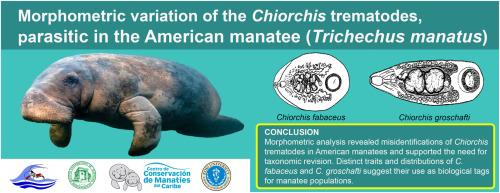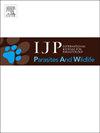美洲海牛(trichecchus manatus)寄生吸虫毛细毛线虫的形态变异
IF 2.2
3区 医学
Q3 ECOLOGY
International Journal for Parasitology-Parasites and Wildlife
Pub Date : 2025-10-06
DOI:10.1016/j.ijppaw.2025.101146
引用次数: 0
摘要
本文研究了寄生于美洲海牛肠道和盲肠的毛毛蜱(cladorchichichidis spp.)成虫的形态变异。1980年至1998年间,在波多黎各、古巴、多米尼加共和国、墨西哥和佛罗里达州收集了22只海牛的标本。在不同地理区域的284个标本的31个形态测量方差分析中,我们发现了统计学上显著的差异,这与两个物种的存在一致。来自佛罗里达州的一些标本符合Chiorchis fabaceus Diesing1838的描述,而来自多米尼加共和国、墨西哥、波多黎各和佛罗里达州的一些标本(以前被错误地识别为C. fabaceus)符合C. groschafti Coy-Otero1989的描述。后者支持了寄生在美洲海牛身上的两种基兰氏菌的区别。这些种类的区别主要在于有无食道球、睾丸形状、生殖孔的位置以及卵泡的形状和分布。本文章由计算机程序翻译,如有差异,请以英文原文为准。

Morphometric variation of the Chiorchis trematodes, parasitic in the American manatee (Trichechus manatus)
Morphological variation was studied in the adult cladorchiid trematodes Chiorchis spp. (Trematoda: Digenea), that parasitize the intestinal tract and caecum of the American manatee (Trichechus manatus). Specimens were collected from 22 manatees between 1980 and 1998 in Puerto Rico, Cuba, Dominican Republic, Mexico, and Florida. We found statistically significant differences in analyses of variance in 31 morphological measurements from 284 specimens across different geographical regions, consistent with the existence of two species. Some specimens from Florida corresponded to the description for Chiorchis fabaceus Diesing1838, while specimens from the Dominican Republic, Mexico, Puerto Rico, and some from Florida, previously misidentified as C. fabaceus, corresponded to the description of C. groschafti Coy-Otero1989. The latter supports the distinction of two Chiorchis species parasitic on the American manatee. These species differ mainly by the presence or absence of an esophageal bulb, testes shape, position of the genital pore, and shape and distribution of the vitelline follicles.
求助全文
通过发布文献求助,成功后即可免费获取论文全文。
去求助
来源期刊

International Journal for Parasitology-Parasites and Wildlife
Medicine-Infectious Diseases
CiteScore
3.80
自引率
5.60%
发文量
113
审稿时长
45 days
期刊介绍:
The International Journal for Parasitology: Parasites and Wildlife (IJP-PAW) publishes the results of original research on parasites of all wildlife, invertebrate and vertebrate. This includes free-ranging, wild populations, as well as captive wildlife, semi-domesticated species (e.g. reindeer) and farmed populations of recently domesticated or wild-captured species (e.g. cultured fishes). Articles on all aspects of wildlife parasitology are welcomed including taxonomy, biodiversity and distribution, ecology and epidemiology, population biology and host-parasite relationships. The impact of parasites on the health and conservation of wildlife is seen as an important area covered by the journal especially the potential role of environmental factors, for example climate. Also important to the journal is ''one health'' and the nature of interactions between wildlife, people and domestic animals, including disease emergence and zoonoses.
 求助内容:
求助内容: 应助结果提醒方式:
应助结果提醒方式:


